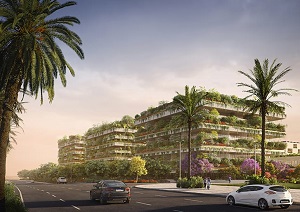 Friday, April 26, 2024
Friday, April 26, 2024  Friday, April 26, 2024
Friday, April 26, 2024 
As reported on CNN Style, home to the ancient pyramids, Egypt is no stranger to architectural innovation. So it is no surprise that it is set to become the first African nation to host a “vertical forest.”
Italian architect Stefano Boeri has unveiled plans for three cube-shaped vertical forest apartment blocks for Egypt’s new administrative capital, currently being built in the desert 30 miles east of Cairo.
Advertise YOUR business on Construction Links Network – Download the media kit
Boeri is an architect on a mission. A manifesto published on his firm’s website commits to “a global campaign on urban forestry” that spans city farms, roof gardens, green facades and other forms of public greenery. His signature tower blocks, first erected in his home city of Milan, are adorned with lush foliage which not only looks beautiful but also provides environmental and health benefits.
Working in conjunction with Egyptian designer Shimaa Shalash and Italian landscape architect Laura Gatti, Boeri’s practice — Stefano Boeri Architetti — has unveiled designs for three buildings covered in planted terraces in Egypt.
Each of the three will measure 30 meters (98ft) by 30 meters (98ft), and rise seven storys high. Boeri estimates that the trio, designed for property developer Misr Italia Properties, will hold 350 trees and 14,000 shrubs of over 100 species overall.
According to Boeri’s website, the vertical forest scheme is a “project for the environmental survival of contemporary cities” designed to promote the “coexistence of architecture and nature in urban areas”. They seek to regenerate urban environments without expanding the city’s sprawling footprint. Each tower of trees aims to provide its human residents with an average of two trees, eight shrubs and 40 bushes each.